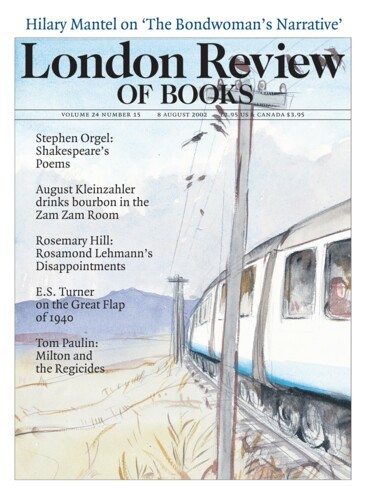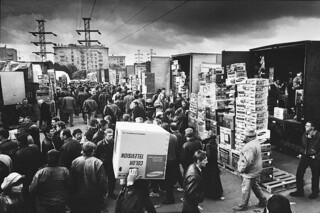As you come into Moscow from Sheremetevo airport, the way is guarded by a monument marking the limit of the German advance in October 1941: red girders protrude from a sloping plinth, forming a line of three skewed crosses, replicating in miniature the anti-tank defences that once stood here. Then, this would have been an open field: now the monument doubles as the gate to Khimki – more a satellite than a suburb of Moscow, but essentially the city’s beginning. Just beyond it is the vast blue oblong of an Ikea store, doubtless taken by many arrivals as a sign of the free market’s firm entrenchment in Russian soil. But soon the apartment blocks appear: prefabricated concrete units hastily assembled in the 1960s and 1970s, already crumbling. Behind them and between them the endlessly flat horizon muscles in; here, as elsewhere in Moscow’s outlying suburbs, the city seems barely to have taken hold, as if the march of the legions of birch trees ringing it had been halted only temporarily.
The broad thoroughfare into the centre – the final stretch of the St Petersburg-Moscow road – is lined by vast showpiece apartment blocks built in the weighty neoclassical mode of the Stalin era. But despite their scale, these buildings begin to seem like stage sets as soon as you notice what fills the spaces behind them. There is a striking uncertainty about Moscow urbanism, a looseness in its grip on the landscape, something Walter Benjamin, who was in Moscow from December 1926 to February 1927, observed with perceptive perplexity:
In the streets of Moscow there is a curious state of affairs: the Russian village is playing hide-and-seek in them. If you step through one of the high gateways . . . you stand on the threshold of a spacious settlement. Opening before you, broad and expansive, is a farmyard or a village, the ground is uneven, children ride about in sleighs, sheds for wood and tools fill the corners, trees stand here and there, wooden staircases give the backs of houses, which look like city buildings from the front, the appearance of Russian farmhouses. Frequently churches stand in these yards, just as on a large village green. So the street is augmented by the dimension of landscape.
When Benjamin visited, a gateway marked a passage between modes of life. Now, the wooden sheds he saw in the yards behind the buildings have given way to rows of steel carapaces, like small freight containers, under which Muscovites lock their cars. The triumphal arches piercing monumental apartment blocks open onto courtyards that retain an after-image of the rural that has been blurred by urban adaptation: play is now organised by climbing frames; benches have been installed for conversation and drinking. Moscow is full of spaces that seem not to know whether they belong to the city or to a fading notion of village life: no man’s lands between modernity and its antecedents. The layout of Moscow’s buildings has preserved, as if by genetic transmission, the patterns of the gorodskaya usadba, the ‘urban estate’, built by aristocrats to replicate in the city their larger holdings in the country. Behind the main building would be a number of others which, with the abolition of private property and the redistribution of living space after 1917, were separated by undefined yards. More recent structures, the 1960s and 1970s blocks, are surrounded by trees sheltering similarly semi-public spaces.
Older patterns assert themselves on a larger scale, too: what are now the Boulevard and Garden Rings used to be the concentric circles of fortifications radiating from the Kremlin, punctuated by monasteries bristling with crenellations. After Napoleon’s invasion in 1812 – when fleeing Muscovites set the city alight – reconstruction was directed at turning Moscow into a stately neoclassical rival to the then capital, St Petersburg: the Bolshoi Theatre was built in the early 1820s, the Boulevard Ring was created, trees were planted and decorous buildings were erected, made of stone instead of wood and characteristically painted yellow with white plaster flourishes, in the belief that they would bring with them urban sophistication. But Moscow’s overall character remained that of a ‘big village’ (a phrase Muscovites still use), with low, dimly lit buildings straggling along narrow lanes – what Trotsky referred to as an ‘ant-like piling up of quarters and streets’.
The immediate post-Revolutionary period saw a rash of bold plans for Moscow’s reconstruction, but the city’s version of Haussmanisation came only with the 1935 General Plan for the Reconstruction of Moscow, which involved widening streets and cutting vast arterial roads through the huddled buildings and meandering lanes. But even Stalinist modernisation was not incompatible with older architectural modes. On Tverskaya Street in 1938 Arkady Mordvinov erected what came to be known as ‘curtain buildings’, barely two apartments deep, which gave the street a series of suitably triumphant façades, behind which wooden buildings and churches were left intact.
Since 1991 Moscow has seen an explosion of billboards, neon signs and advertising panels. One reason for this rush of signage must be the anti-functional character of much of the city’s architecture. Soviet shops were on the ground floor of apartment blocks, and everyone would go to their nearest one, labelled simply ‘Shoes’ or ‘Fruit’; the frontages of these buildings didn’t need to be designed to appeal to customers. New businesses have to tout their wares from these unpromising premises, as local residents digest the replacement of comprehensible labels with meaningless company names. But there are too few of these shops to accommodate the vast numbers of small-scale businesses, and commerce has invaded the yards behind the buildings; advertising panels direct you from the street to shops selling car parts or camera films, buried in the semi-rural depths of a yard. Kiosks swarm round every underpass, Metro entrance and train station, selling anything from food and alcohol to pirated CD-ROMs and stereo components. In the underpasses, there are dozens upon dozens of fruit vendors, bookstalls, people selling odd items of clothing, bath toys – a daily market lodged in the city’s interstices.
Many of these people are engaging in a less visible form of begging, a form of commerce that is only the thinnest of substitutes for the real thing. A woman selling a set of teaspoons, clearly the family silver, for example, and others selling medals and ID cards. This is not trade or market behaviour in any normal sense, unless it’s a market in desperation. A brief step up the economic ladder from this are people selling a few strange, miscellaneous objects – siphons from spray-cleaners, for instance – in a kind of senseless specialisation. There is a whole sector of the population eking out a living in a pale reflection of the processes of capitalism, coerced into commerce by inadequate and unpaid state pensions. Benjamin spoke of begging in 1920s Moscow as a ‘corporation of the dying’; Moscow’s forgotten underclass are already social and economic ghosts.
Much of the city’s economic life unfolds outdoors, independent of Moscow’s decaying structures. The city of real buildings is being supplanted by a city of stalls and kiosks, a city made entirely of accretions. The two Moscows – the one ready to sink into architectural oblivion, the other floating free into the realm of limitless exchange – inhabit the same space. This is not to say that nothing new has been built since 1991 – the Okhotny Ryad shopping centre and a ghastly monument to Peter the Great, both Luzhkov’s mayoral follies; scores of new apartment blocks on the outskirts; shiny offices for banks and oil companies – but Moscow’s infrastructure is very little altered. The city of accretions is more than simply a response to the advent of a pseudo-capitalist economy: it is also an extreme expression of the Postmodern sensibility – a turn to the realm of images, away from the physical reality of dilapidation. The frequent deployment of reflective surfaces and mirrored glass is a feature of much Postmodern architecture; Moscow Postmodernism combines the impermeable exteriors of American corporate headquarters with gestures towards the palette and decorative flourishes of the city’s neoclassical and baroque buildings, effecting a double introversion: blocking the outsider’s gaze, and repeating elements of an architecture that always turned away from the street.
Send Letters To:
The Editor
London Review of Books,
28 Little Russell Street
London, WC1A 2HN
letters@lrb.co.uk
Please include name, address, and a telephone number.


